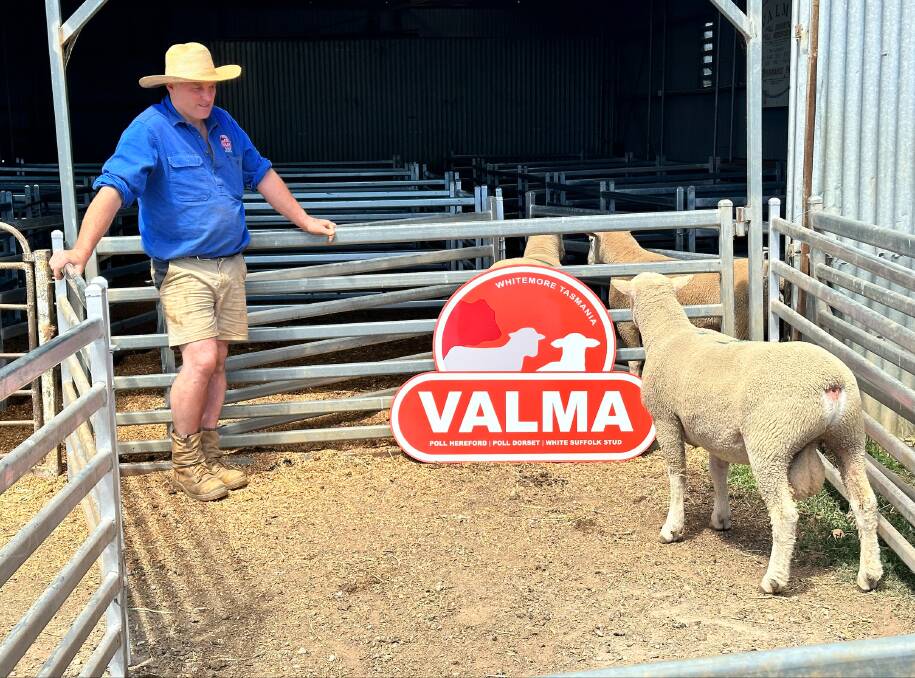
The equal top-priced ram from Tasmanian Poll Herefords, Poll Dorsets and White Suffolk stud Valma, Whitemore's annual sale has gone to a property five minutes up the road.
Subscribe now for unlimited access to all our agricultural news
across the nation
or signup to continue reading
Valma sold two sale-topping Poll Dorsets - lots 13 and 16 - for $2500 each.
The stud sold 134 Poll Dorset rams, out of 159, for an average of $1169.
The top price for a White Suffolk ram was $1800, achieved three times.
Valma sold 87 White Suffolks, of 138 offered, averaging $1053.
The sale was back on last year, with Valma stud principal Andrew McLauchlan citing seasonal conditions and poorer sheep prices as the reason.
Lot 13 went to Bramwell Heazlewood, at Melton Vale Poll Dorset stud, Whitemore, while lot 16 was bought by Stephen James, Colebrook, Tas.
Mr McLauchlan said buyers of the top-priced rams were attracted by the animals' figures.
Lot 13, and August 2022-drop ram sired by Valma 210168, had figures of a birthweight (Bwt) of 0.52 kilograms, a weaning weight (Wwt) of 11.16kg and a post-weaning weight (Pwwt) of 16.97.
His intramuscular fat (IMF) measurement was 0.17, Shear Force 5, (SF5) 0.32, post weaning eye muscle depth (PEMD) 3.45 and post weaning fat depth (Pfat) 0.02.
Mr Heazelwood said Melton Vale had been breeding Poll Dorsets for more than 50 years.
"My interest in him was on his eating quality figures and his breeding background - I have been chasing eating quality in our flock for nearly 10 years," Mr Heazelwood said.
He said the ram had "a reasonable amount of Valma genetics," which could also be incorporated into the Melton Vale flock.
He paid $2500, due to the stud transfer fee.
The second top-priced ram, lot 16, a June 2022-drop ram, was sired by Felix-200213
He had Bwt of 0.27kg, Wwt of 12.15kg and a Pwwt of 18.34kg.
The ram had an IMF of -0.13, a SF5 of 3.74, Pemd of 3.81mm and Pfat of 0.18.
He had a TCP of 162.37.
Valma offered 323 Poll Dorset and White Suffolk rams.
"We have been building bit-by-bit, for the last few years, with the strength of the lamb markets and the seasons," Mr McLauchlan said.
"It's very hard to change, we have to look out two years from when you have a sale," he said.
'It's very hard to adjust, according to seasons and the lamb market - it's a bit like looking into a crystal ball."
He said the stud had been selling a lot of rams and wanted to keep numbers were they were.
"When things get better again prices will come back - some clients didn't come this year because they are cutting back on numbers and not mating as many ewes.
"They didn't need to buy rams, but they will be back next year."
He said it was "all about riding those waves."
Sale of the White Suffolk rams was quieter, as buyers who used them over Merinos had been hit hard by the climatic conditions.
"I think that's the main factor, some of the people using White Suffolks were cutting their numbers back - we had more clients probably pulling out, not buying them, than for the Dorsets," Mr McLauchlan said.
"I think most of the Dorsets tend to go over composite lines and tend to be a little bit more stable in their numbers.
"I think some producers were also putting ewes back to Merino rams."
Webb and Woodiwiss livestock agent Mark Webb, Whitemore, a "big percentage of Dorsets went into north east Tasmania, to two large operations there.
"The rest went to local buyers."
White Suffolks went right throughout Tasmania, with many clients through the Midlands and Derwent Valley, he said.
Rams also went into the Goulburn area, NSW.


